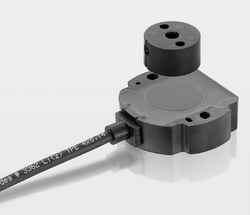
Posted to News on 24th Nov 2014, 10:19
Non-contacting sensor for electro-hydraulic actuators
Modern automation technology is relying on exact positional data for moving machinery parts. The measurement values are provided by linear and rotary sensors, which must be immune to temperature, vibrations, and other environmental influences. In addition, many applications regularly require fast movement cycles, high-frequency oscillations, and/or continuous mechanical rotation. For this reason, non-contacting processes, which are practically free of wear and tear, have become increasingly prevalent. They are employed in the electro-hydraulic actuators of pipeline ball valves, for instance.

Currently, the operating principles applied for non-contacting rotary sensing often include magnetic processes. They yield absolute measurements which are reliable even under tough environmental conditions. Their relatively low cost in comparison with other measurement technologies makes them suitable for countless applications in machine engineering and plant design. This allows for a large spectrum of applications. They are represented in assemblies ranging from wind direction measuring systems, over actuators, control valves, handling systems, and industrial robotics to mobile applications for utility vehicles, such as for tractors, harvesters, etc. And these versatile angle sensors offer interesting possibilities for position measuring in pedals, seat positioning systems, or panel joysticks. They are now even utilised in hydroelectric power plants or pipelines.
A good example is the RSC 2800 series magnetic rotary sensors from the product range of sensor technology specialist Novotechnik. Koso America, for example, utilises the robust sensor for position sensing inside an electro-hydraulic actuator suitable for ball valves of varying nominal width. This application uses the sensor signal to control the precise adjustment of the ball valve within milliseconds. The electro-hydraulic actuator basically comprises two main components: the drive itself, consisting of hydraulic cylinder, control circuit, and power module, as well as a control unit. The drive is mounted directly atop the ball valve on the pipeline, while the control unit can be installed remotely. The power module includes an electric motor for the delivery of oil into the dual-action hydraulic cylinder. This cylinder can move in either direction, depending on requirements.
Impervious to contaminants
The rotary sensor plays an important role in positioning. It is mounted directly on the slide shaft and provides the current positional real value as a 4 ... 20mA analogue signal to be sent to the control unit. The touchless measurements are not affected by the vibrations commonly occurring during pump or pipeline operation. What's more, the sensor is impervious to contaminants and moisture. Its basic operation is quite simple: a magnet is mounted on the rotational axis. Depending on the rotation angle, the orientation of the magnetic field changes, and with it the signal voltage of the sensor component. Within the sensor's integrated circuits, this signal change is then converted into an analogue signal that is proportionally related to the rotation angle. And this sensor is very accurate: it features a 12 bit resolution, which corresponds to a positional resolution of .02 per cent or an angular resolution of +/- 0.1 degree. The independent linearity amounts to approximately +/- 0.5 per cent.
The control unit calculates the difference between real value and target value. If it exceeds a certain value, adjustments are made. To that end, the control unit first calculates the required pressure direction for clockwise or counter clockwise motion; then the actuator valves open, so that the drive is moved into the target position. Afterwards, the valves close off the cylinder's inlet and outlet, locking it in the resulting position. This method is highly economical, as there will be hardly any energy consumption after reaching the target position. In addition, the closed circuit does not require a large oil reservoir, which also conserves resources.
The sensors were easily integrated into the application described. Their design allows for easy coupling and eliminates play. Elongated holes in the housing simplify mounting and adjustment. A shielded cable cast into the housing is used for the electrical connection; however, M12 connectors and other connector types are also optionally available. Depending on the application, the user can choose between input voltages of 5V and 24V. Ambient temperatures between -40 and +85degC, as well as between -25 and +85degC (with connector) are acceptable; models for up to +125degC are available.
Simple design
In addition, the simple design of the magnetic angle sensors provides for another attractive option for many applications for which angle sensors were previously not suitable (for instance because of space requirements or because the coupling of the shaft would have been too difficult or even impossible to implement). These applications can be realised with a magnetic angle sensor, in which the sensor and position marker are designed as physically separate components.
The magnetic position marker (position transducer) is installed on the rotating shaft. A marker indicates the correct alignment with the sensor component, which may be placed at a distance of up to 4mm from the position transducer. Using an available stronger magnet, even larger separation distances of up to approx. 10mm are possible. This dual-component design provides the user with the greatest possible freedom of installation for the angle sensor, e.g. for retrofits. Since neither shaft nor bearings are required, and because the sensing distance is variable, application-specific bearing tolerances are not a problem. Furthermore, transmissive measuring through other (non-magnetic) materials, such as plastics or aluminium, is an option. Hence, it appears that there may be further interesting applications in the magnetic rotary sensors' future.
For more imformationabout non-contacting sensors, go to www.variohm.com.
Want the latest machine building news straight to your inbox? Become a MachineBuilding member for free today >>

















